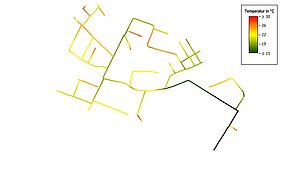Increased water temperatures in the drinking water network already pose a challenge for water supply companies. The objective of the research project was to develop the basis for various fields of action for dealing with the problem of increased water temperatures in the distribution system on the basis of extensive investigations.
Global climate change has a significant impact on many areas of the environment, with the increase in heat waves in the summer months, which lead to an increasing warming of the environment, being a particularly relevant effect. This warming also affects the soil zones in which the drinking water pipes are laid. The extent to which drinking water in drinking water pipe networks in Germany is affected by warming has not yet been scientifically investigated. The approach of the research project was to investigate the processes of warming and to develop practical approaches for assessing the temperature situation in the drinking water pipe network. The overall aim was to develop a basis for various fields of action for dealing with the problem of high water temperatures in the drinking water pipe network.
The survey of the participating water suppliers conducted at the beginning of the project showed that water temperatures in the drinking water pipe network of 25 °C and more are a reality and that water temperatures can lead to customer complaints.
The measurements in the drinking water pipe networks have shown that the water temperature increases in the summer months depending on the flow conditions. The highest water temperatures in the drinking water pipe network were measured in branch pipes and stagnant network areas. Seven water suppliers with usable data from measurements in the drinking water pipe network recorded maximum water temperatures of 20 °C in all cases and over 25 °C in four cases, i.e. over 50 %. The maximum was 30 °C.
To simulate the water temperature in the drinking water pipe network, the approach developed by RBS wave GmbH and the Fischer-Uhrig engineering office before the start of the project and implemented in the STANET calculation software was verified. With a complete calibration of the hydraulic calculation network model, the calculation approach can be used to achieve highly accurate water temperature statements in the drinking water pipe network.
By measuring the soil temperature with soil temperature probes at different depths, the processes of soil warming could be identified. The surface temperature is essentially determined by the factors of air temperature, solar radiation and surface properties. With increasing depth, the heat input via the surface is attenuated. Temperature peaks with corresponding attenuation and delay could be identified down to a depth of 1.5 m. Soil temperature measurements from eight water suppliers were taken into account in the evaluation. In five cases, and thus in more than 50 %, soil temperatures of 25 °C were exceeded at depths of approx. 1 m and in several cases also at depths of 1.2 and 1.5 m. These were predominantly sunny locations with a paved surface.
A numerical soil model was developed to calculate the soil temperature development, which can also take the effect of other heat sources into account. A simple approach to estimating the risk of heating in the drinking water pipe network is to use satellite data and divide the network areas according to assumed hydraulic conditions.
As a result of the developed understanding of the process, longer-term measures can be derived for the sustainable control of the temperature problem. The approaches developed can be used to test which measures are actually sustainable in practice under which boundary conditions.There is a need to revise the W397 regulations, particularly with regard to the assumption of the characteristic summer temperature.

![[Translate to English:] Prüfstelle-Produktprüfung_Teststand Test centre and product testing](/fileadmin/_processed_/0/9/csm_TZW-Karlsruhe_Pruefung_Geraete-Teststand_377188946c.jpg)

























